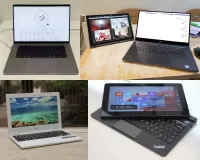Intel Corporation, headquartered in Santa Clara, California, is a multinational technology company specializing in the design, manufacture, and sale of computer components, primarily CPUs, for both business and consumer markets. As of 2024, it was the world's third-largest semiconductor chip manufacturer by revenue and has consistently ranked among the Fortune 500 since 2007. Intel was also one of the first companies listed on Nasdaq. Since 2025, the United States government has a partial ownership stake in Intel.
July 18, 1968: Intel Founded
On July 18, 1968, Intel was founded by semiconductor pioneers Gordon Moore and Robert Noyce, along with investor Arthur Rock.
April 1969: Introduction of the first Intel logo
In April 1969, Intel introduced its first logo, designed by Robert Noyce and Gordon Moore. The logo featured the company name in lowercase Helvetica font with a "dropped-e".
April 1969: Original logo
In April 1969, the new logo retained a classic feel seen in the original logo.
1969: Introduction of Memory Products
In 1969, Intel introduced the 3101 Schottky TTL bipolar 64-bit static random-access memory (SRAM), the 3301 Schottky bipolar 1024-bit read-only memory (ROM), and the 256-bit 1101, the first commercial MOSFET silicon gate SRAM chip.
1970: Release of the 1103 DRAM
In 1970, Intel released the 1103, the first commercially available dynamic random-access memory (DRAM).
November 15, 1971: Introduction of the Intel 4004 Microprocessor
On November 15, 1971, the Intel 4004, Intel's first microprocessor, was introduced to the mass market, originally developed for the Japanese company Busicom.
1971: Introduction of Intel 4004 Microprocessor
In 1971, Intel created the first commercially available microprocessor, the Intel 4004.
1971: First Commercial Microprocessor Chip
In 1971, Intel created the world's first commercial microprocessor chip, the Intel 4004.
1972: 1103 becomes best selling chip
By 1972, Intel's 1103 became the bestselling semiconductor memory chip in the world.
1972: First International Manufacturing Facility
In 1972, Intel opened its first international manufacturing facility in Malaysia.
1973: Creation of First Microcomputer
In 1973, Intel created one of the first microcomputers.
1975: Project to develop 32-bit microprocessor started
In 1975, Intel initiated a project to create an advanced 32-bit microprocessor.
1978: Completion of the 8086 microprocessor
In 1978, Intel completed the 8086 microprocessor (and its variant the 8088) and launched "Operation Crush," a major marketing campaign. This effort led to a design win with IBM's newly created PC division.
1981: IBM introduces its personal computer
In 1981, IBM introduced its successful personal computer.
1981: Release of Intel iAPX 432
In 1981, Intel released the Intel iAPX 432, a highly advanced 32-bit microprocessor. However, the processor failed to meet its performance objectives and was not successful in the market.
1981: Memory Chips Business
Until 1981, Intel's business was primarily focused on static (SRAM) and dynamic random-access memory (DRAM) chips.
1982: Intel creates the 80286 microprocessor
In 1982, Intel created the 80286 microprocessor.
1983: Profitability Reduction in DRAM Market
By 1983, increased competition from Japanese semiconductor manufacturers had dramatically reduced the profitability of the DRAM market.
1983: Intel focuses on microprocessors
In 1983, Intel, under then-president Andy Grove, shifted its focus to microprocessors due to increased pressure from Japanese memory-chip manufacturers. This transition, detailed in Grove's book "Only the Paranoid Survive", involved becoming the single source for successors to the 8086 microprocessor.
1984: Intel Scientific Computers division founded
In 1984, the Intel Scientific Computers division was founded by Justin Rattner, to design and produce parallel computers.
1984: Semiconductor Chip Protection Act of 1984
In 1984, the Semiconductor Chip Protection Act of 1984 was enacted, recognizing intellectual property rights related to microprocessor topology, a law sought by Intel and the Semiconductor Industry Association (SIA).
1985: Compaq produces first IBM PC "clone" based on 80286
In 1985, Compaq, the first IBM PC "clone" manufacturer, produced a desktop system based on the faster 80286 processor.
1986: Compaq produces first 80386-based system
In 1986, Compaq followed up with the first 80386-based system, outpacing IBM and fostering a competitive market for PC-compatible systems. This event solidified Intel's position as a major component supplier.
1989: Intel Introduces the 486 Microprocessor
In 1989, Intel introduced the 486 microprocessor.
1989: Intel petitions MicroAge to favor Intel chips
In 1989, Intel's Dennis Carter visited MicroAge's headquarters to persuade them to encourage their computer suppliers to favor Intel chips, arguing it was too difficult to educate PC buyers on the value of Intel processors.
1990: Intel Established a Second Design Team
In 1990, Intel established a second design team to design the processors code-named "P5" and "P6" in parallel.
1991: "Intel Inside" becomes a worldwide branding campaign
In 1991, "Intel Inside", originally "The Computer Inside", became a worldwide branding campaign, spearheaded by Intel marketing manager Dennis Carter.
1991: Intel Inside marketing campaign launch
In 1991, Intel launched its Intel Inside marketing campaign.
1991: "Intel Inside" marketing and branding campaign launched
In 1991, Intel launched the "Intel Inside" marketing and branding campaign. This initiative established Intel, a component supplier previously unknown outside the PC industry, as a household name.
1991: Antitrust lawsuit against Intel
In 1991, antitrust allegations had been simmering and had been the cause of one lawsuit against Intel.
1992: Intel Scientific Computers division renamed
In 1992, the Intel Scientific Computers division was renamed to the Intel Supercomputing Systems Division.
1993: Intel Introduces the Pentium
In 1993, Intel introduced the P5 processor as the Intel Pentium, replacing the former part number with a registered trademark name.
1993: Intel sued for age discrimination
In 1993, Intel was sued by nine former employees over allegations that they were laid off because they were over the age of 40.
1993: Santa Clara design team starts P7 project
In 1993, Intel's Santa Clara design team began work on the "P7", a successor to the x86 architecture.
June 1994: Flaw discovered in the Pentium microprocessor
In June 1994, Intel engineers discovered a flaw in the floating-point math subsection of the P5 Pentium microprocessor, leading to incorrect results in certain calculations.
October 1994: Pentium FDIV bug discovered independently
In October 1994, Thomas Nicely, a professor of mathematics, independently discovered the FDIV bug in Intel's Pentium processor. He posted about his finding on the Internet after receiving no response from Intel. The issue spread quickly, leading to public pressure and a recall of the defective CPUs, costing Intel $475 million.
1994: Introduction of the five-note jingle
In 1994, Intel introduced its five-note jingle, which became widely recognized in 130 countries within a decade.
1994: Creation of the "Intel Spiral" jingle
In 1994, the D♭–D♭–G♭–D♭–A♭ xylophone/marimba jingle, known as the "Intel Spiral", was produced by Musikvergnuegen and written by Walter Werzowa to coincide with the launch of the Pentium.
1994: Intel Spiral created
In 1994, the United States Copyright Office registered a copyright claim to the sound recording of the "Intel Spiral".
1995: Ken Hamidi fired from Intel
FACE Intel was founded by Ken Hamidi, who was fired from Intel in 1995 at the age of 47.
1995: Release of Pentium Pro
In 1995, Intel released the P6 as the Pentium Pro, improving upon it later into the Pentium II.
1997: Release of Pentium II
In 1997, the Pentium Pro was improved into the Pentium II.
1999: Hamidi blocked from using Intel's email system
Hamidi was blocked in a 1999 court decision from using Intel's email system to distribute criticism of the company to employees.
1999: Modification of the Intel jingle
In 1999, the Intel jingle was modified to coincide with the launch of the Pentium III processor.
1999: Intel jingle overlapped
In 1999, the new Intel jingle overlapped the Intel jingle from 1994.
2000: Slowdown in Demand for High-End Microprocessors
After 2000, growth in demand for high-end microprocessors slowed, and competitors like AMD gained market share.
June 2001: Introduction of the Itanium
In June 2001, Intel introduced the Itanium, which was the implementation of the IA-64 64-bit architecture. However, its performance with legacy x86 code was underwhelming, leading to its failure against x86-64.
2002: Dell and Intel agreement regarding rebates
From 2002 to 2006, Dell had an agreement with Intel to receive rebates in exchange for not using chips manufactured by AMD. Dell did not disclose these substantial rebates to investors but used them to help meet investor expectations regarding the company's financial performance.
2003: Accusations of excessive VOC releases from Intel's Rio Rancho plant
In 2003, Intel was accused by some residents of Rio Rancho, New Mexico, of allowing volatile organic compounds (VOCs) to be released in excess of their pollution permit.
2003: Exclusivity Payments of Dell
In FY 2003, exclusivity payments grew to 10% of Dell's operating income
2003: Court overturns decision blocking Hamidi from using Intel's email system
The 1999 court decision was overturned in 2003 in Intel Corp. v. Hamidi.
2003: European Commission alleges anti-competitive practices by Intel
The allegations, going back to 2003, include giving preferential prices to computer makers buying most or all of their chips from Intel, paying computer makers to delay or cancel the launch of products using AMD chips, and providing chips at below standard cost to governments and educational institutions.
2004: AMD claims against Intel
In 2004, AMD brought claims against Intel related to unfair competition.
2004: Neo Sans Intel designed
In 2004, Sebastian Lester designed Neo Sans Intel. It is a customized version of Neo Sans based on the Neo Sans and Neo Tech.
2004: Remake of the Intel jingle
In 2004, the Intel jingle was remade for the second time to coincide with the new logo change.
June 6, 2005: Apple to Use Intel Processors
On June 6, 2005, Apple announced that it would be using Intel's x86 processors for its Macintosh computers, switching from the PowerPC architecture.
September 2005: Intel responds to AMD lawsuit
In September 2005, Intel responded to AMD's lawsuit, disputing the claims and asserting its business practices as fair and lawful. Intel argued that AMD's struggles stemmed from poor business decisions, such as underinvestment in manufacturing capacity. Legal analysts predicted a lengthy legal battle due to Intel's unwillingness to settle.
November 2005: Images of the new brand identity had begun circulating online
In November 2005, Images of Intel's new brand identity began circulating online via a French site known as x86-Secret, before being taken down by Intel's legal team and later reuploaded by Taiwanese site DigiTimes.
2005: AMD claims against Intel
In 2005, AMD brought further claims against Intel related to unfair competition.
2005: Company Reorganization
In 2005, CEO Paul Otellini reorganized Intel to refocus its core processor and chipset business on platforms like enterprise, digital home, digital health, and mobility.
2005: Intel found violating Japanese Antimonopoly Act
In 2005, the local Fair Trade Commission found that Intel violated the Japanese Antimonopoly Act. The commission ordered Intel to eliminate discounts that had discriminated against AMD to avoid a trial, Intel agreed to comply with the order.
January 3, 2006: Introduction of the second Intel logo
On January 3, 2006, Intel officially introduced its second logo, created by FutureBrand, which combined elements of the previous logo and the Intel Inside campaign. It abandoned the "dropped-e" in favor of a "vortex" and featured a stylized version of the new Neo Sans Intel font, alongside the "Leap Ahead" tagline.
January 10, 2006: First Mac computers containing Intel CPUs announced
On January 10, 2006, Apple announced the first Mac computers containing Intel CPUs.
January 2006: Intel drops the Pentium name from their processors
In January 2006, Intel announced that they were dropping the long running Pentium name from their processors, and began phasing out the Pentium names from mobile processors first with the new Yonah chips branded Core Solo and Core Duo.
February 2006: South Korean officials raid Intel's offices
In February 2006, South Korean officials raided Intel's South Korean offices as part of an antitrust investigation.
June 27, 2006: Sale of XScale Assets Announced
On June 27, 2006, Intel announced the sale of its XScale processor business to Marvell Technology Group for an estimated $600 million.
July 2006: Reports document VOC releases from Intel's Rio Rancho site
During a sub-committee meeting of the New Mexico Environment Improvement Board, a resident claimed that Intel's own reports documented more than 1,580 pounds (720 kg) of VOCs released in June and July 2006 from their Rio Rancho site.
July 27, 2006: Core 2 family released
On July 27, 2006, the Intel Core 2 family was released. It was based on the Intel Core microarchitecture, and was a 64-bit design.
August 2006: Apple transitioned its entire line of consumer Macs to Intel processors
By early August 2006, Apple had transitioned its entire line of consumer Macs to Intel processors.
October 2006: Transmeta filed a lawsuit against Intel
In October 2006, Transmeta filed a lawsuit against Intel for patent infringement on computer architecture and power efficiency technologies.
November 9, 2006: Acquisition Completed
On November 9, 2006, the acquisition of Intel's XScale processor business by Marvell Technology Group was completed.
November 2006: Apple Xserve server updated to Intel Xeon processors
From November 2006, the Apple Xserve server was updated to Intel Xeon processors and was offered in a configuration similar to Apple's Mac Pro.
2006: Dell adopts AMD as secondary supplier, Intel stops rebates
In 2006, Dell eventually adopted AMD as a secondary supplier, and Intel subsequently stopped their rebates, causing Dell's financial performance to fall.
2006: Intel expands promotion of open specification platforms
In 2006, Intel expanded its promotion of open specification platforms beyond Centrino, to include the Viiv media center PC and the business desktop Intel vPro.
2006: Introduction of Neo Sans Intel
In 2006, Intel introduced Neo Sans Intel alongside its rebranding efforts. Previously, Intel used Helvetica as its standard typeface in corporate marketing.
2006: Unveiling of Core Microarchitecture
In 2006, Intel unveiled its Core microarchitecture, which was well-received and significantly improved processor performance.
2006: The mainstream of Intel jingle
In 2006, the mainstream version of the Intel jingle was retained since it's launch with the Core processors.
July 2007: European Commission accuses Intel of anti-competitive practices
In July 2007, the European Commission accused Intel of anti-competitive practices, mainly against AMD. The allegations, going back to 2003, include giving preferential prices to computer makers buying most or all of their chips from Intel, paying computer makers to delay or cancel the launch of products using AMD chips, and providing chips at below-standard cost to governments and educational institutions. Intel responded that the allegations were unfounded.
September 2007: South Korean regulators accuse Intel of antitrust violations
In September 2007, South Korean regulators accused Intel of breaking antitrust law. The investigation began in February 2006 when officials raided Intel's South Korean offices. Intel risked a penalty of up to 3% of its annual sales if found guilty.
October 2007: Settlement of the lawsuit
In October 2007, Intel and Transmeta settled their patent infringement lawsuit, with Intel agreeing to pay US$150 million initially and US$20 million per year for the next five years. Both companies agreed to drop lawsuits against each other, while Intel was granted a perpetual non-exclusive license to use current and future patented Transmeta technologies in its chips for 10 years.
2007: Start of Intel property tax evasion
Between 2007 and 2008, Intel evaded payment of property taxes to the tune of ₹340 million (US$4.0 million).
2007: Exclusivity Payments of Dell
In the first quarter of FY 2007, exclusivity payments peaked at 76%.
2007: Included in Fortune 500 list
Since 2007, Intel has been included in the Fortune 500 list of the largest United States corporations by revenue.
January 2008: New York starts investigation of Intel for antitrust violations
In January 2008, New York initiated an investigation into Intel regarding potential antitrust law violations in the pricing and sales of its microprocessors.
February 2008: EU Regulators raid Intel's Munich office
In February 2008, Intel announced that its office in Munich had been raided by European Union regulators. Intel reported that it was cooperating with investigators.
June 2008: EU files new charges against Intel
In June 2008, the EU filed new charges against Intel regarding anti-competitive practices.
June 2008: Intel fined US$25.5 million by South Korean regulators for antitrust violations
In June 2008, the Fair Trade Commission ordered Intel to pay a fine of US$25.5 million for leveraging its dominant position to offer incentives to major Korean PC manufacturers on the condition that they do not buy products from AMD.
June 2008: Federal Trade Commission begins antitrust investigation of Intel
In June 2008, the Federal Trade Commission (FTC) also launched an antitrust investigation into Intel's business practices.
November 2008: Release of 1st-generation Core processors based on Nehalem microarchitecture
In November 2008, Intel released the 1st-generation Core processors based on the Nehalem microarchitecture. Intel also introduced a new naming scheme, with the three variants now named Core i3, i5, and i7.
2008: End of Intel property tax evasion
Between 2007 and 2008, Intel evaded payment of property taxes to the tune of ₹340 million (US$4.0 million).
2008: Intel began shipping mainstream solid-state drives (SSDs)
In 2008, Intel began shipping mainstream solid-state drives (SSDs) with up to 160 GB storage capacities, using industry standards such as NAND flash, mSATA, PCIe, and NVMe.
2008: Introduction of Penryn Microarchitecture
In 2008, Intel introduced the Penryn microarchitecture, fabricated using the 45 nm process node, and also released a processor with the Nehalem architecture to positive reception.
2008: Intel shifts emphasis of Intel Inside campaign to newer media
In 2008, Intel planned to shift the emphasis of its Intel Inside campaign from traditional media such as television and print to newer media such as the Internet.
2008: Spinoff of Solar Startup Assets
In 2008, Intel spun off key assets of a solar startup business effort to form an independent company, SpectraWatt Inc.
2008: Court date set for AMD lawsuit against Intel
In 2008, a court date was finally set for the AMD antitrust lawsuit against Intel.
May 2009: EU fines Intel €1.06 billion for anti-competitive practices
In May 2009, the EU found that Intel had engaged in anti-competitive practices and subsequently fined Intel €1.06 billion (US$1.44 billion), a record amount. The EU stated that Intel paid companies, including Acer, Dell, HP, Lenovo and NEC, to exclusively use Intel chips in their products, harming other companies including AMD.
November 4, 2009: New York attorney general files antitrust lawsuit against Intel
On November 4, 2009, the New York attorney general filed an antitrust lawsuit against Intel, accusing the company of using "illegal threats and collusion" to dominate the computer microprocessor market.
November 12, 2009: AMD drops antitrust lawsuit against Intel for $1.25 billion
On November 12, 2009, AMD agreed to drop its antitrust lawsuit against Intel in exchange for $1.25 billion. Both companies released a joint statement expressing that the agreement would end legal disputes and allow them to focus on product innovation and development.
November 2009: New York Attorney General sues Intel for bribery and coercion
In November 2009, New York Attorney General Andrew Cuomo filed a lawsuit against Intel, accusing the company of bribery and coercion, alleging Intel bribed computer makers to favor their chips over rivals and threatened to withdraw payments if computer makers worked too closely with competitors. Intel denied these claims.
December 2009: FTC to initiate administrative proceeding against Intel
In December 2009, the Federal Trade Commission (FTC) announced that it would initiate an administrative proceeding against Intel in September 2010.
2009: Intel uses a good–better–best strategy with Celeron, Pentium, and Intel Core
By 2009, Intel was using a good–better–best strategy with Celeron being good, Pentium better, and the Intel Core family representing the best the company has to offer.
2009: Intel announces effort to remove conflict resources from supply chain
In 2009, Intel announced its plan to remove conflict resources—materials sourced from mines whose profits fund armed militant groups—from its supply chain.
2009: Intel's mainstream processors
Since 2009, Intel's mainstream processors have been called Celeron, Pentium, Core i3, Core i5, Core i7, and Core i9 in order of performance from lowest to highest.
July 22, 2010: Dell settles with SEC for $100 million over accounting disclosures
On July 22, 2010, Dell agreed to a settlement with the U.S. Securities and Exchange Commission (SEC) to pay $100 million in penalties resulting from charges that Dell did not accurately disclose accounting information to investors. The SEC charged that from 2002 to 2006, Dell had an agreement with Intel to receive rebates in exchange for not using chips manufactured by AMD.
September 2010: FTC administrative proceeding against Intel
In September 2010, the Federal Trade Commission began its administrative proceeding against Intel regarding antitrust concerns.
2010: Intel allocated $1.8 billion to advertising
In 2010, Intel's annual financial report indicated that $1.8 billion (6% of the gross margin and nearly 16% of the total net income) was allocated to all advertising with Intel Inside being part of that.
2010: Westmere microarchitecture released
In 2010, the Westmere microarchitecture, a die shrink to 32 nm including Intel HD Graphics, succeeded the Nehalem microarchitecture.
2010: "Centrino" applied to WiMAX and Wi-Fi technologies
Since 2010, the "Centrino" brand is exclusively applied to Intel's WiMAX and Wi-Fi technologies.
February 2011: Construction of New Manufacturing Facility
In February 2011, Intel began building a new microprocessor manufacturing facility in Chandler, Arizona.
April 2011: Pilot project with ZTE
In April 2011, Intel began a pilot project with ZTE Corporation to produce smartphones using the Intel Atom processor for China's domestic market.
October 2011: Intel sells its Core i7-2700K "Sandy Bridge" chip
In October 2011, Intel started to sell its Core i7-2700K "Sandy Bridge" chip to customers worldwide.
December 2011: Reorganization into Mobile and Communications Group
In December 2011, Intel announced that it reorganized several of its business units into a new mobile and communications group.
2011: Release of Sandy Bridge-based 2nd-generation Core processor family
In 2011, Intel released the Sandy Bridge-based 2nd-generation Core processor family, featuring an 11% performance increase over Nehalem.
2011: SpectraWatt files for bankruptcy
In 2011, SpectraWatt filed for bankruptcy.
2011: Partnership with Google announced
Intel's partnership with Google was announced at the Intel Developers Forum (IDF) in 2011 in San Francisco.
2011: Rumors of Apple switching from Intel processors to their own designs began circulating
Rumors of Apple switching from Intel processors to their own designs began circulating as early as 2011.
January 2012: Android 2.3 Support for Intel Atom
In January 2012, Google announced Android 2.3, supporting Intel's Atom microprocessor.
2012: Introduction of Ivy Bridge-based 3rd-generation Core at the Intel Developer Forum
In 2012, Intel introduced the Ivy Bridge-based 3rd-generation Core at the Intel Developer Forum. Ivy Bridge featured a die shrink to 22 nm and supported both DDR3 memory and DDR3L chips.
2012: Intel ranked best by Enough Project on conflict mineral progress
In its 2012 rankings on the progress of consumer electronics companies relating to conflict minerals, the Enough Project rated Intel the best of 24 companies, calling it a "Pioneer of progress".
2012: Planned introduction of Medfield processor
Intel planned to introduce Medfield – a processor for tablets and smartphones – to the market in 2012, as an effort to compete with Arm.
July 2013: Intel Custom Foundry Division Clients
As of July 2013, five companies—Achronix, Tabula, Netronome, Microsemi, and Panasonic—were using Intel's fabs through the Intel Custom Foundry division. Most were field-programmable gate array (FPGA) makers, with only Achronix shipping chips made by Intel using the 22 nm Tri-Gate process.
October 2013: Alliance for Affordable Internet (A4AI) Launch
In October 2013, the Alliance for Affordable Internet (A4AI) was launched, with Intel as part of the coalition of public and private organizations.
2013: Intel to support all tier-one operating systems
In 2013, Intel announced they would now support all "tier-one operating systems" such as Linux, Android, iOS, and Chrome.
2013: Completion of Chandler Facility
In 2013, Intel completed its new microprocessor manufacturing facility in Chandler, Arizona, at a cost of $5 billion.
2013: Foundry Agreement with Altera
In 2013, Intel, facing excess fab capacity due to the Ultrabook's failure and declining PC sales, entered a foundry agreement with Altera to produce chips using a 14 nm process, with intentions to pursue further deals.
June 2014: General Court rejects Intel's appeal against EU fine
In June 2014, the General Court, which sits below the European Court of Justice, rejected Intel's appeal against the €1.06 billion fine imposed by the EU for anti-competitive practices.
November 2014: Intel designs a Paddington Bear statue
In November 2014, Intel designed a Paddington Bear statue, named "Little Bear Blue", as part of a charity event in London. The statue was located outside Framestore in Chancery Lane, London, a visual-effects company that uses Intel technology.
November 2014: Intel planning to use optical fibers to improve networking within supercomputers
In November 2014, Intel stated that it was planning to use optical fibers to improve networking within supercomputers.
2014: Intel CEO announces conflict-free microprocessors
During a keynote address at Consumer Electronics Show 2014, Intel CEO Brian Krzanich announced that the company's microprocessors would henceforth be conflict-free.
2014: Announcement of Intel Clear
In 2014, Intel announced Intel Clear, a global font designed for use across all communications. It was designed by Red Peek Branding and Dalton Maag and replaced Neo Sans Intel as the company's corporate typeface.
2014: Typeface changed to Intel Clear
In 2014, Intel changed the typeface to Intel Clear, which was created by Red Peak Branding and Dalton Maag.
2014: Employee Cuts
In 2014, Intel cut thousands of employees in response to "evolving market trends".
2014: Intel urges industry to shun conflict minerals
In 2014, chief executive Brian Krzanich urged the rest of the industry to follow Intel's lead by also shunning conflict minerals.
2014: Phase out of Intel jingle
In 2014, the 1994 version of the Intel jingle was phased out.
2014: Intel Inside branding changed to reflect the new Intel Clear font
In 2014, the Intel Inside branding was updated to use the new Intel Clear font.
November 19, 2015: OpenFog Consortium founded
On November 19, 2015, Intel, alongside other companies and Princeton University, founded the OpenFog Consortium to promote interests and development in fog computing. Jeff Fedders from Intel became the consortium's first president.
2015: Cadence Exported Chips to China
Between 2015 and 2021, Cadence Design Systems unlawfully exported chips to China while Lip-Bu Tan was CEO.
April 2016: Cancellation of SoFIA and Broxton Atom SoC
In April 2016, Intel cancelled the SoFIA platform and the Broxton Atom SoC for smartphones, effectively leaving the smartphone market.
August 2016: Indian officials threaten to dump garbage on Intel's campus over unpaid taxes
In August 2016, Indian officials of the Bruhat Bengaluru Mahanagara Palike (BBMP) threatened to dump garbage trucks on Intel's campus for evading payment of property taxes between 2007 and 2008, to the tune of ₹340 million (US$4.0 million).
2016: Tick-tock model deprecated
In 2016, Intel deprecated its tick-tock model of microarchitecture development, ushering in the process–architecture–optimization model with the release of the 7th-generation Core family based on Kaby Lake.
2016: Initial Plan to Introduce 10 nm Products
In 2016, Intel originally planned to introduce 10 nm products.
2016: Intel expects conflict-free supply chain
In 2016, Intel stated that it expected its entire supply chain to be conflict-free by the end of the year.
2017: Itanium chips discontinued
In 2017, Intel announced that the Itanium 9700 series (Kittson) would be the last Itanium chips produced.
2017: Intel became a sponsor of the Olympic Games
In 2017, Intel became a sponsor of the Olympic Games, with the sponsorship lasting from the 2018 Winter Olympics to the 2024 Summer Olympics.
2017: Delay of Mass Production of 10 nm Products
In 2017, Intel delayed the mass production of their 10 nm products.
2017: Intel Introduced SSDs based on 3D XPoint technology under the Optane Brand Name
In 2017, Intel introduced SSDs based on 3D XPoint technology under the Optane brand name.
2017: Copyright Claim to "Intel Spiral" Sound Recording
In 2017, the United States Copyright Office registered a copyright claim to the 1994 sound recording of the "Intel Spiral," recognizing its creative authorship, but refused registration for the underlying musical composition due to a lack of originality.
January 2018: Meltdown and Spectre Security Flaws Reported
In early January 2018, it was reported that all Intel processors made since 1995 (besides Intel Itanium and pre-2013 Intel Atom) had been subject to two security flaws dubbed Meltdown and Spectre.
2018: Further Delay of 10 nm Product Mass Production, Cannon Lake Release
In 2018, Intel further delayed mass production of their 10 nm products and released Cannon Lake (marketed as 8th-generation Core) in small quantities.
2018: Cannon Lake released in small quantities
In 2018, Intel's Cannon Lake (marketed as 8th-generation Core), the first microarchitecture under the 10 nm node, was released in small quantities.
2018: Sponsorship of the Olympic Games
In 2018, Intel's sponsorship of the Olympic Games began, lasting until the 2024 Summer Olympics.
September 2019: Introduction of 10th-generation Intel Core Mobile Processors
In September 2019, Intel finally introduced mass-produced 10 nm 10th-generation Intel Core mobile processors (codenamed "Ice Lake").
2019: Release of Intel's 10th-generation of Core processors
In 2019, Intel released the 10th-generation of Core processors, codenamed "Amber Lake", "Comet Lake", and "Ice Lake". Ice Lake was produced on the 10 nm process and was limited to low-power mobile processors.
June 22, 2020: Apple announces transition to Arm-based processors
On June 22, 2020, Apple announced that it would be transitioning its entire Mac line from Intel CPUs to custom Apple-designed processors based on the Arm architecture over the course of the next two years.
September 2, 2020: Introduction of the third Intel logo
On September 2, 2020, Intel introduced its third logo, created by Andrew Mirikian Design using Intel One. The logo was inspired by previous logos and was meant to convey a sense of tradition and reliability.
September 2020: 11th-generation Core mobile processors launched
In September 2020, Intel launched 11th-generation Core mobile processors, codenamed Tiger Lake. Tiger Lake is based on the Willow Cove microarchitecture and a refined 10 nm node.
November 2020: Apple unveils the M1 processor
By November 2020, Apple unveiled the M1, its custom-designed processor for the Mac.
2020: Apple Transitions to Apple Silicon
In 2020, Apple began transitioning away from the x86 architecture and Intel processors to their own Apple silicon for their Macintosh computers.
2020: Continued Use of Skylake Microarchitecture
In 2020, Intel continued to use the Skylake microarchitecture, albeit with optimizations, due to struggles with shrinking the process node from 14 nm to 10 nm.
2020: New typeface, Intel One, was designed.
In 2020, as part of a new visual identity, a new typeface, Intel One, was designed. It replaced Intel Clear as the font used by the company in most of its branding, however, it is used alongside Intel Clear typeface. In logo, it replaced Neo Sans Intel typeface.
2020: Debut of the new jingle
In 2020, with Intel's new visual identity, another remake of the jingle debuted. The company has made use of numerous variants since its rebranding, while retaining the mainstream 2006 version.
2020: Intel's Dominance in Server CPU Market
Intel's market share in the server CPU market has slipped from over 90% in 2020.
March 23, 2021: Pat Gelsinger Lays Out New Plans: IDM 2.0
On March 23, 2021, CEO Pat Gelsinger outlined a new strategy called IDM 2.0, which includes investments in manufacturing facilities, use of internal and external foundries, and a new foundry business called Intel Foundry Services (IFS).
March 30, 2021: 11th-generation Core desktop processors released
On March 30, 2021, Intel released 11th-generation Core desktop processors (codenamed "Rocket Lake"), fabricated using Intel's 14 nm process and based on the Cypress Cove microarchitecture. It replaced Comet Lake desktop processors. All 11th-generation Core processors feature new integrated graphics based on the Intel Xe microarchitecture.
2021: Cadence Exported Chips to China
Between 2015 and 2021, Cadence Design Systems unlawfully exported chips to China while Lip-Bu Tan was CEO.
2021: Intel releases more optimizations on Skylake microarchitecture
From 2016 until 2021, Intel later released more optimizations on the Skylake microarchitecture with Kaby Lake R, Amber Lake, Whiskey Lake, Coffee Lake, Coffee Lake R, and Comet Lake.
2021: Release of 12th-generation Intel Core processors (Alder Lake)
In 2021, Intel released 12th-generation Intel Core processors (codenamed "Alder Lake"). This generation is fabricated using Intel's 10 nm process, called Intel 7, for both desktop and mobile processors, and is based on a hybrid architecture utilizing high-performance Golden Cove cores and high-efficiency Gracemont (Atom) cores.
2021: SK Hynix acquired most of Intel's NAND memory business
In 2021, SK Hynix acquired most of Intel's NAND memory business for $7 billion. Intel also discontinued its consumer Optane products in 2021.
2021: Appointment of Pat Gelsinger as CEO
Since Pat Gelsinger's appointment in 2021, Intel faced mounting challenges, including a $16.6 billion loss and a 60% drop in share prices.
January 2022: Selection of New Albany, Ohio for Manufacturing Facility
In January 2022, Intel reportedly selected New Albany, Ohio, as the site for a major new manufacturing facility costing at least $20 billion.
July 2022: Intel ceases future product development within its Optane business
In July 2022, Intel disclosed in its Q2 earnings report that it would cease future product development within its Optane business, which in turn effectively discontinued the development of 3D XPoint as a whole.
August 2022: $30 Billion Partnership with Brookfield Asset Management
In August 2022, Intel signed a $30 billion partnership with Brookfield Asset Management to fund its factory expansions in Chandler. Intel retained a controlling stake by funding 51% of the cost.
2022: EU dropped fine on Intel
In 2022 the €1.06 billion fine was dropped.
2022: Intel drops Pentium and Celeron naming schemes
In 2022, Intel announced that they are dropping the Pentium and Celeron naming schemes for their desktop and laptop entry level processors.
2022: Value of Debentures Equivalent
In 2022, the $2,500,000 of convertible debentures offered in 1968 was equivalent to $21 million.
January 31, 2023: Pay Cuts Announced as Part of Cost Reductions
On January 31, 2023, Intel announced pay cuts affecting employees above midlevel, ranging from 5% upwards, as part of a $3 billion cost reduction plan.
September 2023: EU Re-imposes fine on Intel
In September 2023 the €1.06 billion fine was dropped but was successively re-imposed as a €376.36 million fine.
October 2023: Confirmed First Commercial User of High-NA EUV Lithography Tool
In October 2023, Intel confirmed it would be the first commercial user of the high-NA EUV lithography tool as part of its plan to regain process leadership from TSMC.
December 2023: Unveiling of Gaudi3 AI Chip
In December 2023, Intel unveiled Gaudi3, an artificial intelligence (AI) chip for generative AI software.
2023: Intel leads x86 market
As of 2023, Intel leads the x86 market with a 68.4% market share.
2023: Intel drops 'i' in processor markings
In 2023, Intel announced they will be dropping the 'i' in their future processor markings. For example, products such as Core i7, will now be called Core 7. Ultra will be added to the endings of processors that are in the higher end, such as Core Ultra 7.
2023: "Intel Processor" branding replaces old Pentium and Celeron naming schemes
Starting in 2023, the "Intel Processor" branding will be replacing the old Pentium and Celeron naming schemes.
2023: Initial Plan for Construction Start in Magdeburg
The start of construction for the chip mega factories in Magdeburg, Germany, was initially planned for 2023.
June 4, 2024: Announcement of AI Chips for Data Centers, Xeon 6 Processor
On June 4, 2024, Intel announced AI chips for data centers, the Xeon 6 processor, aiming for better performance and power efficiency.
August 2024: Announcement of 15,000 Job Cuts
In August 2024, Intel announced that it intends to cut 15,000 jobs to save $10 billion in 2025 after posting $1.6 billion in losses for Q2.
September 24, 2024: Release of Lunar Lake Processors for AI PCs
On September 24, 2024, Intel disclosed architecture details for its Lunar Lake processors for AI PCs.
November 1, 2024: Announcement of Removal from Dow Jones Industrial Average
On November 1, 2024, it was announced that Intel will drop out of the Dow Jones Industrial Average on November 8, with Nvidia taking its place.
November 2024: Class-action lawsuit filed against Intel over Raptor Lake CPU instability
In November 2024, a group of Intel customers who had purchased the company's Raptor Lake CPUs filed a class-action lawsuit against Intel, alleging that the company was aware of instability issues affecting 13th and 14th generation Raptor Lake CPUs but failed to disclose this to customers.
December 2024: Ousting of CEO Pat Gelsinger
In December 2024, Intel's CEO Pat Gelsinger was ousted amid ongoing struggles to revitalize the company, with David Zinsner and Michelle Johnston Holthaus appointed as interim co-CEOs.
2024: AMD's Advances in Server CPU Market
In 2024 and 2025, AMD made significant advances in the server CPU market, narrowing the gap with Intel. Initial reports of a near-equal market split were later corrected due to manipulated benchmark data.
2024: Annual Sponsorships
In 2024, Intel and Riot Games had an annual sponsorship valued at US$5 million, and one with JD Gaming for US$3.3 million. The company also had a sponsorship with Global Esports.
2024: World's third-largest semiconductor chip manufacturer by revenue
In 2024, Intel was the world's third-largest semiconductor chip manufacturer by revenue.
2024: Postponement of Construction Start in Magdeburg
The start of construction for the chip mega factories in Magdeburg, Germany, has been postponed to late 2024.
March 13, 2025: Appointment of Lip-Bu Tan as New CEO
On March 13, 2025, Intel announced the appointment of Lip-Bu Tan as their new CEO, effective March 18, after four months of having interim co-CEOs.
April 2025: New Marketing Campaign Announced
In April 2025, Intel's chief marketing officer, Brett Hannath, announced a new marketing campaign, "That's the power of Intel Inside," to showcase the usage of Intel products across different markets and industries.
July 2025: Confirmation of Layoffs and Scrapping of Investment Plans
In July 2025, Intel confirmed that it would let go of nearly 24,000 employees and announced plans to scrap "tens of billions" of planned investments in new chip facilities in Europe.
August 7, 2025: Call for Tan's Removal as CEO
On August 7, 2025, President Trump called for Lip-Bu Tan's removal as CEO due to his China connections, causing Intel shares to drop more than 3% during intra-day trading.
August 11, 2025: Meeting Between Tan and President Trump
On August 11, 2025, Lip-Bu Tan met with President Trump and other officials at the White House; President Trump described the meeting as "interesting" and Tan's "success and rise is an amazing story" in a Truth Social post.
August 2025: US Government Investment in Intel
In August 2025, the United States government purchased 433.3 million Intel shares, equivalent to a 9.9% stake, at $20.47 per share.
September 2025: Nvidia Investment in Intel
In September 2025, Nvidia invested $5 billion in Intel as part of a partnership to jointly develop data-center and personal-computing CPUs.
October 2025: Talks with AMD to Add as Foundry Customer
In October 2025, it was reported that Intel was in talks to potentially add rival AMD to its foundry customers.
2025: AMD Market Share in Server CPU Market
As of the third quarter of 2025, Intel retained a majority share of the server CPU market at 63.3%, with AMD holding 36.5%.
2025: Remaining transaction with SK Hynix expected
In 2025, a remaining transaction with SK Hynix worth $2 billion is expected to occur.
2025: Expected Chip Production in New Albany Facility
Intel expects the manufacturing facility in New Albany, Ohio to begin producing chips by 2025.
2025: Target Savings Goal
Intel expects to save $10 billion in 2025.
2025: Partially owned by the United States government
Since 2025, Intel is partially owned by the United States government.
2027: Scheduled Production Start in Magdeburg
The production start for the chip mega factories in Magdeburg, Germany, is scheduled for 2027.
Mentioned in this timeline

Riot Games founded in by Brandon Beck and Marc Merrill...

Google LLC is a multinational technology company specializing in online...
California is a U S state on the Pacific Coast...

Samsung Group is a South Korean multinational manufacturing conglomerate and...

A laptop or notebook computer is a small and portable...
India officially the Republic of India is a South Asian...
Trending

8 months ago Davante Adams expresses optimism about Rams, refused talks with 49ers over offer.

24 days ago Jayson Tatum Wants to Play with Son Deuce in NBA for Ten More Years.

7 months ago Stephanie Vaquer Features on WWE SmackDown Amidst Cena & Paul's Ambush.

6 months ago Jason Kelce Wears Patriotic Briefs and Bartends at Charity Event in New Jersey
5 months ago TJ Watt becomes highest-paid non-QB after extension; JJ Watt reacts hilariously.

Tre Johnson is an American professional basketball player currently playing shooting guard for the Washington Wizards in the NBA A...
Popular

Stranger Things created by the Duffer Brothers is a popular...

XXXTentacion born Jahseh Dwayne Ricardo Onfroy was a controversial yet...
The Kennedy Center Honors are annual awards recognizing individuals and...
Turning Point USA TPUSA is an American nonprofit organization founded...

Bernie Sanders is a prominent American politician currently serving as...

Candace Owens is an American conservative political commentator and author...

